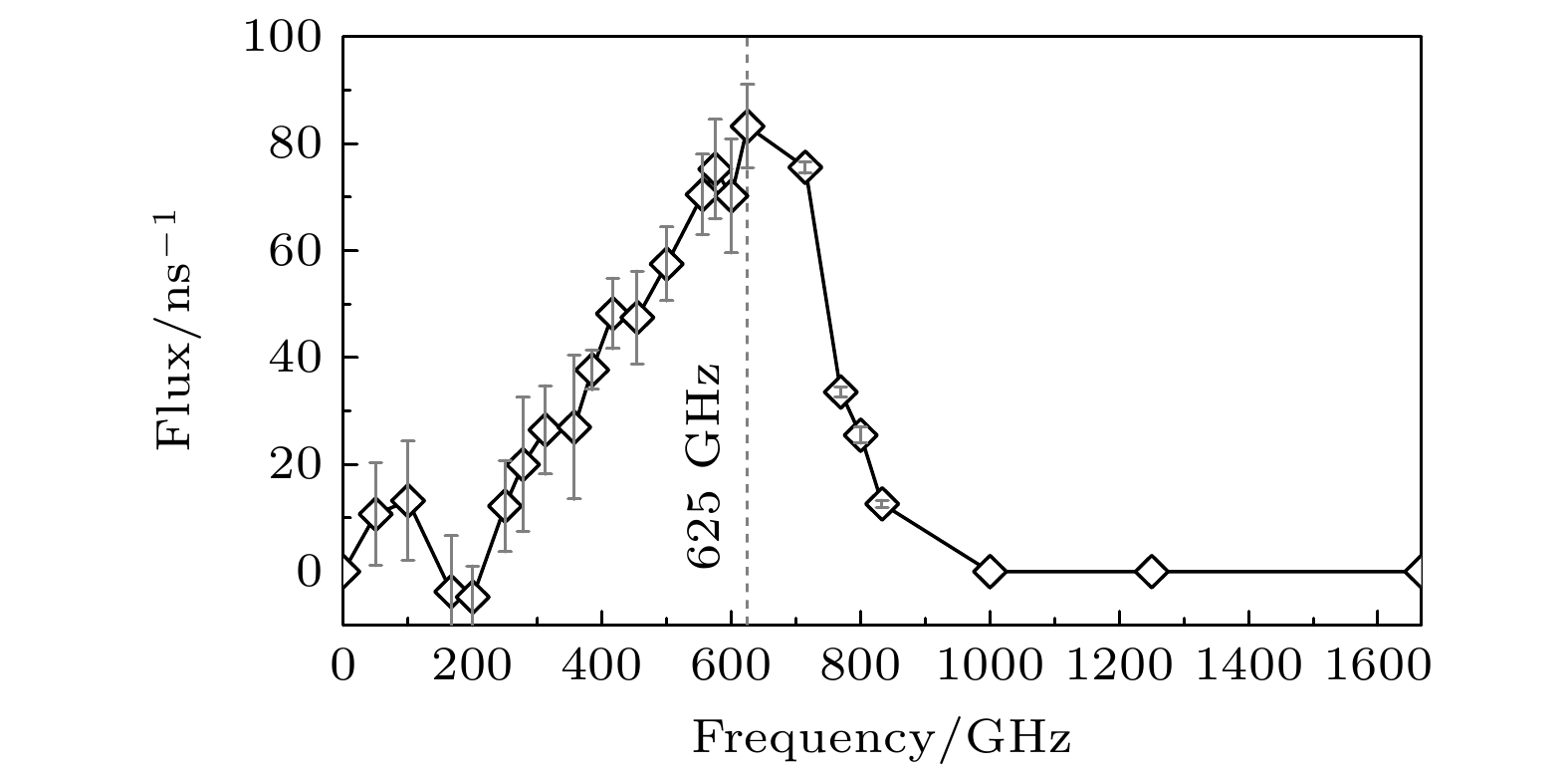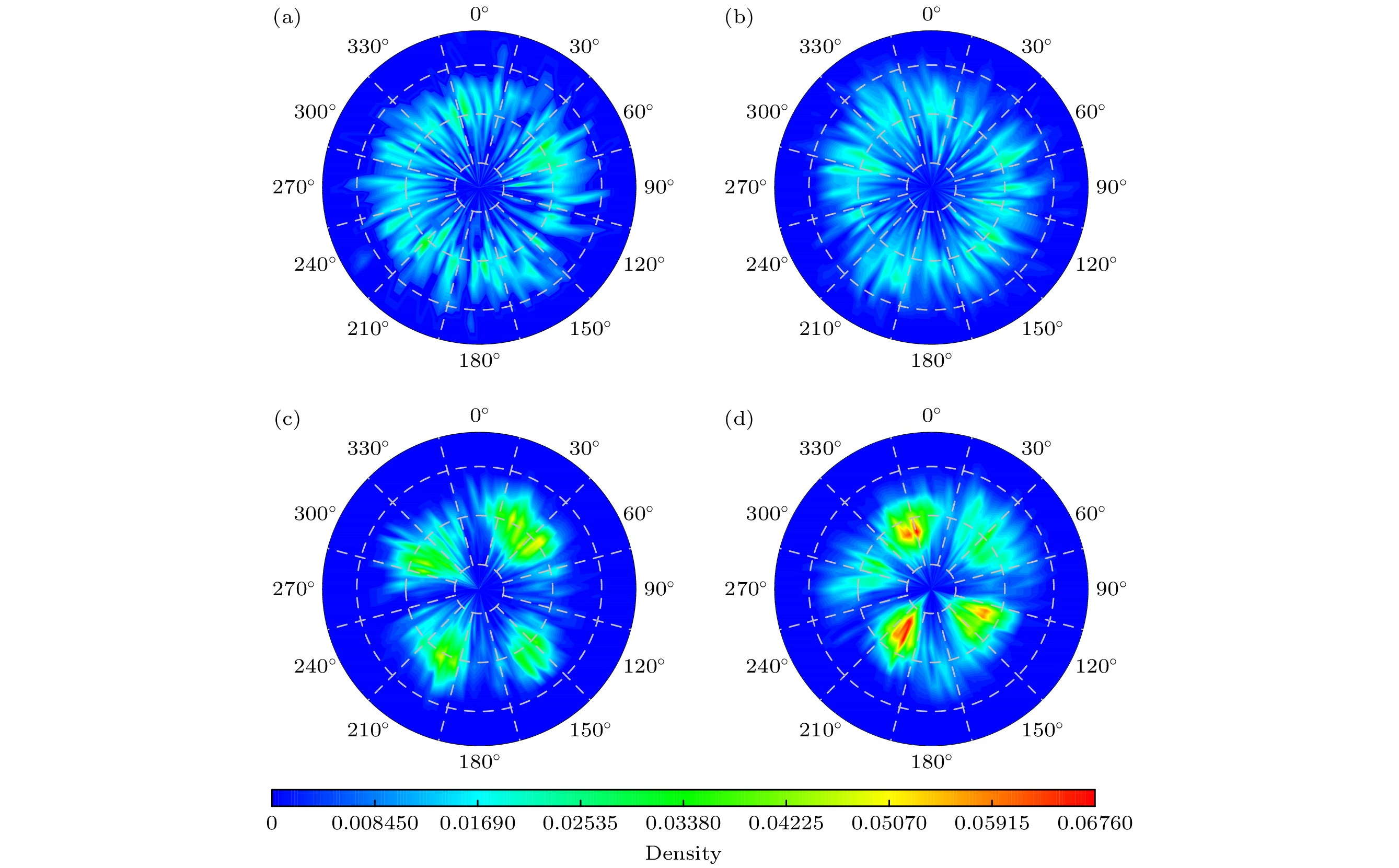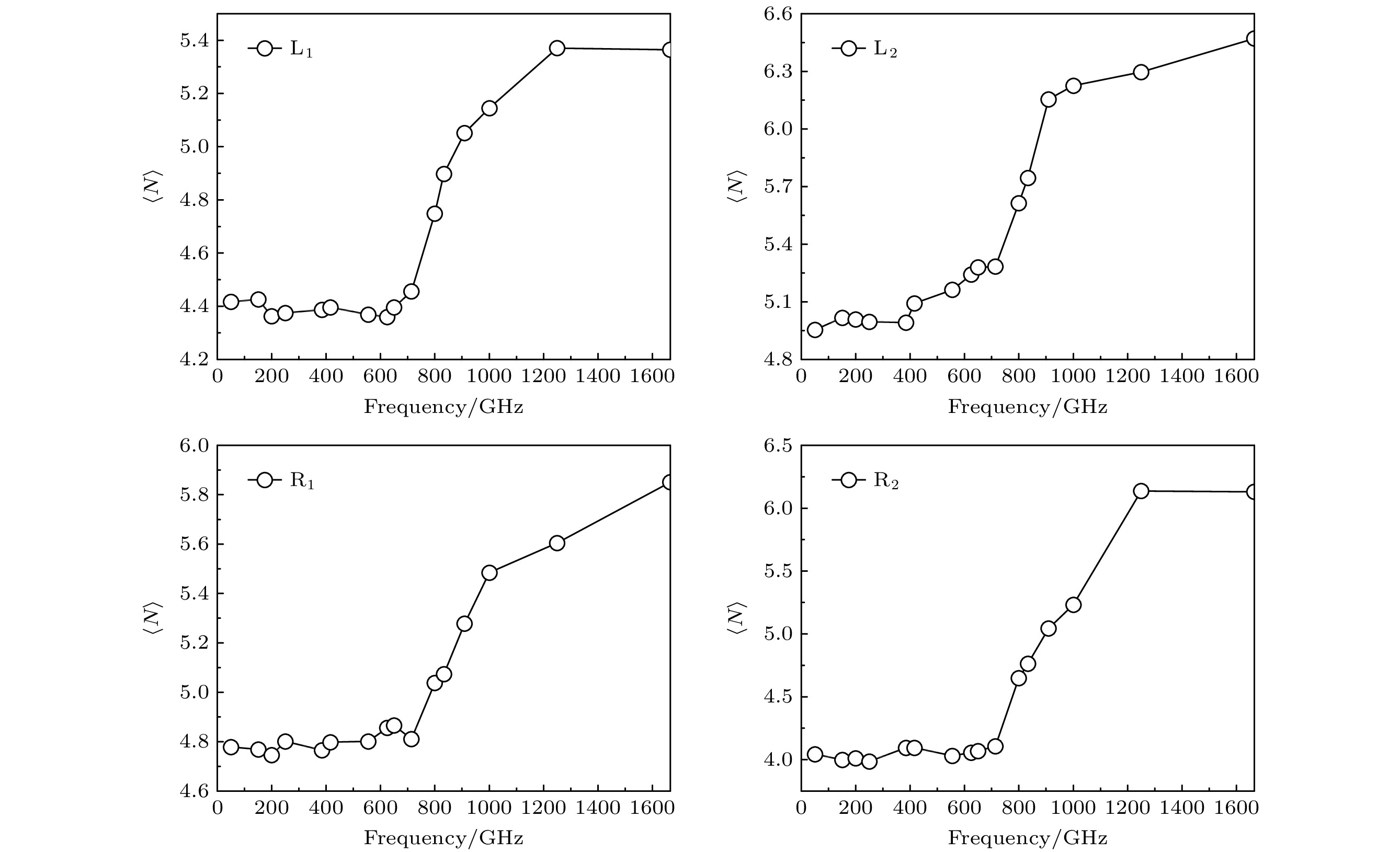-
In the narrow orifice of a cone-shaped channel, blockage can occur for granular matter. However, water molecules can enter into and even permeate through carbon nanotubes of diameters down to 0.8 nm at ultrafast rates. Here we demonstrate by molecular dynamics simulations that clogging can also emerge unexpectedly in the water flowing through a nanoscale valve-less pump. The designed pump features two truncated carbon nanocones, with the narrowest region having a diameter of 1.2 nm (larger than that of (6, 6) carbon nanotube), linked to a fluid cavity volume, and is powered by the vibration of a graphene sheet. In the low frequency range, water molecules can be driven through the nanocones effectively by the vibration of the graphene sheet. The maximum flux reaches 83 ns–1, which is approximately 20 times the measured value of (3.9 ± 0.6) ns–1 for aquaporin-1. However, at higher frequencies, water molecules suffer blockage at the narrow exits. Much unlike granular matter, high-frequency vibration cannot restore water flow. The key to this phenomenon is that in the narrow exits of two nanocones acting as diffuser/nozzle, the number density of water molecules rapidly increases with frequency increasing, the tight hydrogen-bonding network is formed, and the mean lifetime of hydrogen bonds increases dramatically under high-frequency vibrations. High frequency fluctuations in the middle chamber make H-bond network between water molecules in the narrow exits more stable. The probability density distribution of water exhibits a non-equilibrium transition from a disordered state to ordered state. This work reveals a new mechanism of water flowing/blocking in a nanoscale valve-less pump based on two asymmetrical nanocones, offers valuable insights into understanding nonequilibrium jamming transition in nanoscale fluid.
-
Keywords:
- valveless nanopump /
- clogging /
- vibration /
- hydrogen bond network
[1] Squires T M, Quake S R 2005 Rev. Mod. Phys. 77 977
 Google Scholar
Google Scholar
[2] Laser D J, Santiago J G 2004 J. Micromech. Microeng. 14 R35
 Google Scholar
Google Scholar
[3] Whitesides G M 2006 Nature 442 368
 Google Scholar
Google Scholar
[4] Teh S Y, Lin R, Hung L H, Lee A P 2008 Lab Chip 8 198
 Google Scholar
Google Scholar
[5] 蒋丹, 李松晶, 杨平 2013 物理学报 62 224703
 Google Scholar
Google Scholar
Jiang D, Li S J, Yang P 2013 Acta Phys. Sin. 62 224703
 Google Scholar
Google Scholar
[6] Hummer G, Rasaiah J C, Noworyta J P 2001 Nature 414 188
 Google Scholar
Google Scholar
[7] Ghosh S, Sood A K, Kumar N 2003 Science 299 1042
 Google Scholar
Google Scholar
[8] Chen X, Cao G, Han A, Punyamurtula V K, Qiao Y 2008 Nano Lett. 8 2988
 Google Scholar
Google Scholar
[9] Holt J K, Park H G, Wang Y M, Stadermann M, Artyukhin A B, Grigoropoulos C P, Noy A, Bakajin O 2006 Science 312 1034
 Google Scholar
Google Scholar
[10] Fang H P, Wan R Z, Gong X J, Lu H J, Li S Y 2008 J. Phys. D: Appl. Phys. 41 103002
 Google Scholar
Google Scholar
[11] Lu H J, Li J Y, Gong X J, Wan R Z, Zeng L, Fang H P 2008 Phys. Rev. B 77 174115
 Google Scholar
Google Scholar
[12] 方海平 2016 物理学报 65 186101
 Google Scholar
Google Scholar
Fang H P 2016 Acta Phys. Sin. 65 186101
 Google Scholar
Google Scholar
[13] Falk K, Sedlmeier F, Joly L, Netz R R, Bocquet L 2010 Nano Lett. 10 4067
 Google Scholar
Google Scholar
[14] Liu C, Li Z G 2010 Phys. Rev. Lett. 105 174501
 Google Scholar
Google Scholar
[15] Qiu H, Shen R, Guo W L 2011 Nano Res. 4 284
 Google Scholar
Google Scholar
[16] Su J, Guo H 2011 ACS Nano 5 351
 Google Scholar
Google Scholar
[17] Wang Y, Zhao Y J, Huang J P 2011 J. Phys. Chem. B 115 13275
 Google Scholar
Google Scholar
[18] Li X P, Kong G P, Zhang X, He G W 2013 Appl. Phys. Lett. 103 143117
 Google Scholar
Google Scholar
[19] Feng J W, Ding H M, Ren C L, Ma Y Q 2014 Nanoscale 6 13606
 Google Scholar
Google Scholar
[20] Cao W, Wang J, Ma M 2018 Microfluid. Nanofluid. 22 125
 Google Scholar
Google Scholar
[21] Leng J T, Ying T Q, Guo Z R, Zhang Y Y, Chang T C, Guo W L, Gao H J 2022 Carbon 191 175
 Google Scholar
Google Scholar
[22] Zhang Q L, Jiang W Z, Liu J, Miao R D, Sheng N 2013 Phys. Rev. Lett. 110 254501
 Google Scholar
Google Scholar
[23] Kou J, Lu H, Wu F, Fan J, Yao J 2014 Nano Lett. 14 4931
 Google Scholar
Google Scholar
[24] Zhou X Y, Wu F M, Liu Y, Kou J L, Lu H, Lu H J 2015 Phys. Rev. E 92 053017
 Google Scholar
Google Scholar
[25] Zhou X Y, Zhu F Q 2018 Phys. Rev. E 98 032410
 Google Scholar
Google Scholar
[26] Zhu Z, Chang C, Shu Y, Song B 2020 J. Phys. Chem. Lett. 11 256
 Google Scholar
Google Scholar
[27] Fan W, Chen J 2020 Phys. Rev. E 101 010101
 Google Scholar
Google Scholar
[28] 张忠强, 范晋伟, 张福建, 程广贵, 丁建宁 2020 物理学报 69 110201
 Google Scholar
Google Scholar
Zhang Z Q, Fan J W, Zhang F J, Cheng G G, Ding J N 2020 Acta Phys. Sin. 69 110201
 Google Scholar
Google Scholar
[29] Olsson A, Stemme G, Stemme E 2000 Sens. Actuators A Phys. 84 165
 Google Scholar
Google Scholar
[30] Chinappi M, De Angelis E, Melchionna S, Casciola C, Succi S, Piva R 2006 Phys. Rev. Lett. 97 144509
 Google Scholar
Google Scholar
[31] Ai B Q, Liu L G 2008 J. Chem. Phys. 128 024706
 Google Scholar
Google Scholar
[32] Tajkhorshid E, Nollert P, Jensen M O, Miercke L J W, O'connell J, Stroud R M, Schulten K 2002 Science 296 525
 Google Scholar
Google Scholar
[33] Kosztin I, Schulten K 2004 Phys. Rev. Lett. 93 238102
 Google Scholar
Google Scholar
[34] Zhou M, Morais-Cabral J H, Mann S, Mackinnon R 2001 Nature 411 657
 Google Scholar
Google Scholar
[35] Tang J, Behringer R P 2011 Chaos 21 041107
 Google Scholar
Google Scholar
[36] 麻礼东, 杨光辉, 张晟, 林平, 田园, 杨磊 2018 物理学报 67 044501
 Google Scholar
Google Scholar
Ma L D, Yang G H, Zhang S, Lin P, Tian Y, Yang L 2018 Acta Phys. Sin. 67 044501
 Google Scholar
Google Scholar
[37] Janda A, Maza D, Garcimartín A, Kolb E, Clément E 2009 Europhys. Lett. 87 24002
 Google Scholar
Google Scholar
[38] Majumder M, Chopra N, Andrews R, Hinds B J 2005 Nature 438 44
 Google Scholar
Google Scholar
[39] Lindahl E, Hess B, Van Der Spoel D 2001 J. Mol. Model. 7 306
 Google Scholar
Google Scholar
[40] Bussi G, Donadio D, Parrinello M 2007 J. Chem. Phys. 126 014101
 Google Scholar
Google Scholar
[41] Zeidel M, Ambudkar S, Smith B, Agre P 1992 Biochemistry 31 7436
 Google Scholar
Google Scholar
-
图 1 模拟系统图, 由左右两个锥形碳纳米管及中间泵体组成的无阀纳米泵, 通过两个碳平面(灰色小球)连接左右水浴, 红色小球和白色小球分别表示水分子中的氧原子和氢原子; 橘色小球代表振动原子; 左右锥形碳纳米管的窄口端用黄色标记, 分别记为LP (left pore)和RP (right pore)
Fig. 1. Simulation system. A valve-less nanopump consists of carbon nanocones on both sides, a fluid cavity in the center, connected by carbon planes (gray spheres) to two reservoirs. Red and white spheres represent oxygen and hydrogen atoms in water molecules, respectively. The orange sphere represents the vibrating atom. The narrow ends of the carbon nanocones are marked in yellow and labeled as LP (left pore) and RP (right pore), respectively.
图 4 LP和RP区域的平均水分子数, 两个区域厚度为0.4 nm, 分别包含2层水分子, L1和R1分别表示两个区域中右侧的(管径最小)水分子层; L2和R2则表示左侧的水分子层
Fig. 4. Average number of water molecules in each water layer in LP and RP. L1 and R1 represent the right-side (minimum diameter) water molecule layers in the two regions, while L2 and R2 represent the left-side water molecule layers.
图 5 (a)氢键的平均寿命随频率的变化, 插图分别为f = 250 GHz和f = 1250 GHz对应的 LP里第1层水的模拟快照(青色小球表示碳原子, 红色和白色小球分别表示水分子中的氧原子和氢原子); (b) LP区域第1层水分子在横截面上的方位角概率分布图
Fig. 5. (a) Lifetime of hydrogen bonds as a function of the vibration frequency. Two typical snapshots are shown in insets. The cyan spheres represent carbon atoms, with red and white spheres representing oxygen and hydrogen atoms in water molecules. One is for the low frequency (f = 250 GHz) and the other is for the high frequency (f = 1250 GHz). (b) Probability distribution of the azimuthal angle of water molecules in the first layer in the LP region on the cross-section for f = 250 GHz and f = 1250 GHz.
-
[1] Squires T M, Quake S R 2005 Rev. Mod. Phys. 77 977
 Google Scholar
Google Scholar
[2] Laser D J, Santiago J G 2004 J. Micromech. Microeng. 14 R35
 Google Scholar
Google Scholar
[3] Whitesides G M 2006 Nature 442 368
 Google Scholar
Google Scholar
[4] Teh S Y, Lin R, Hung L H, Lee A P 2008 Lab Chip 8 198
 Google Scholar
Google Scholar
[5] 蒋丹, 李松晶, 杨平 2013 物理学报 62 224703
 Google Scholar
Google Scholar
Jiang D, Li S J, Yang P 2013 Acta Phys. Sin. 62 224703
 Google Scholar
Google Scholar
[6] Hummer G, Rasaiah J C, Noworyta J P 2001 Nature 414 188
 Google Scholar
Google Scholar
[7] Ghosh S, Sood A K, Kumar N 2003 Science 299 1042
 Google Scholar
Google Scholar
[8] Chen X, Cao G, Han A, Punyamurtula V K, Qiao Y 2008 Nano Lett. 8 2988
 Google Scholar
Google Scholar
[9] Holt J K, Park H G, Wang Y M, Stadermann M, Artyukhin A B, Grigoropoulos C P, Noy A, Bakajin O 2006 Science 312 1034
 Google Scholar
Google Scholar
[10] Fang H P, Wan R Z, Gong X J, Lu H J, Li S Y 2008 J. Phys. D: Appl. Phys. 41 103002
 Google Scholar
Google Scholar
[11] Lu H J, Li J Y, Gong X J, Wan R Z, Zeng L, Fang H P 2008 Phys. Rev. B 77 174115
 Google Scholar
Google Scholar
[12] 方海平 2016 物理学报 65 186101
 Google Scholar
Google Scholar
Fang H P 2016 Acta Phys. Sin. 65 186101
 Google Scholar
Google Scholar
[13] Falk K, Sedlmeier F, Joly L, Netz R R, Bocquet L 2010 Nano Lett. 10 4067
 Google Scholar
Google Scholar
[14] Liu C, Li Z G 2010 Phys. Rev. Lett. 105 174501
 Google Scholar
Google Scholar
[15] Qiu H, Shen R, Guo W L 2011 Nano Res. 4 284
 Google Scholar
Google Scholar
[16] Su J, Guo H 2011 ACS Nano 5 351
 Google Scholar
Google Scholar
[17] Wang Y, Zhao Y J, Huang J P 2011 J. Phys. Chem. B 115 13275
 Google Scholar
Google Scholar
[18] Li X P, Kong G P, Zhang X, He G W 2013 Appl. Phys. Lett. 103 143117
 Google Scholar
Google Scholar
[19] Feng J W, Ding H M, Ren C L, Ma Y Q 2014 Nanoscale 6 13606
 Google Scholar
Google Scholar
[20] Cao W, Wang J, Ma M 2018 Microfluid. Nanofluid. 22 125
 Google Scholar
Google Scholar
[21] Leng J T, Ying T Q, Guo Z R, Zhang Y Y, Chang T C, Guo W L, Gao H J 2022 Carbon 191 175
 Google Scholar
Google Scholar
[22] Zhang Q L, Jiang W Z, Liu J, Miao R D, Sheng N 2013 Phys. Rev. Lett. 110 254501
 Google Scholar
Google Scholar
[23] Kou J, Lu H, Wu F, Fan J, Yao J 2014 Nano Lett. 14 4931
 Google Scholar
Google Scholar
[24] Zhou X Y, Wu F M, Liu Y, Kou J L, Lu H, Lu H J 2015 Phys. Rev. E 92 053017
 Google Scholar
Google Scholar
[25] Zhou X Y, Zhu F Q 2018 Phys. Rev. E 98 032410
 Google Scholar
Google Scholar
[26] Zhu Z, Chang C, Shu Y, Song B 2020 J. Phys. Chem. Lett. 11 256
 Google Scholar
Google Scholar
[27] Fan W, Chen J 2020 Phys. Rev. E 101 010101
 Google Scholar
Google Scholar
[28] 张忠强, 范晋伟, 张福建, 程广贵, 丁建宁 2020 物理学报 69 110201
 Google Scholar
Google Scholar
Zhang Z Q, Fan J W, Zhang F J, Cheng G G, Ding J N 2020 Acta Phys. Sin. 69 110201
 Google Scholar
Google Scholar
[29] Olsson A, Stemme G, Stemme E 2000 Sens. Actuators A Phys. 84 165
 Google Scholar
Google Scholar
[30] Chinappi M, De Angelis E, Melchionna S, Casciola C, Succi S, Piva R 2006 Phys. Rev. Lett. 97 144509
 Google Scholar
Google Scholar
[31] Ai B Q, Liu L G 2008 J. Chem. Phys. 128 024706
 Google Scholar
Google Scholar
[32] Tajkhorshid E, Nollert P, Jensen M O, Miercke L J W, O'connell J, Stroud R M, Schulten K 2002 Science 296 525
 Google Scholar
Google Scholar
[33] Kosztin I, Schulten K 2004 Phys. Rev. Lett. 93 238102
 Google Scholar
Google Scholar
[34] Zhou M, Morais-Cabral J H, Mann S, Mackinnon R 2001 Nature 411 657
 Google Scholar
Google Scholar
[35] Tang J, Behringer R P 2011 Chaos 21 041107
 Google Scholar
Google Scholar
[36] 麻礼东, 杨光辉, 张晟, 林平, 田园, 杨磊 2018 物理学报 67 044501
 Google Scholar
Google Scholar
Ma L D, Yang G H, Zhang S, Lin P, Tian Y, Yang L 2018 Acta Phys. Sin. 67 044501
 Google Scholar
Google Scholar
[37] Janda A, Maza D, Garcimartín A, Kolb E, Clément E 2009 Europhys. Lett. 87 24002
 Google Scholar
Google Scholar
[38] Majumder M, Chopra N, Andrews R, Hinds B J 2005 Nature 438 44
 Google Scholar
Google Scholar
[39] Lindahl E, Hess B, Van Der Spoel D 2001 J. Mol. Model. 7 306
 Google Scholar
Google Scholar
[40] Bussi G, Donadio D, Parrinello M 2007 J. Chem. Phys. 126 014101
 Google Scholar
Google Scholar
[41] Zeidel M, Ambudkar S, Smith B, Agre P 1992 Biochemistry 31 7436
 Google Scholar
Google Scholar
计量
- 文章访问数: 4054
- PDF下载量: 44
- 被引次数: 0














 下载:
下载:




